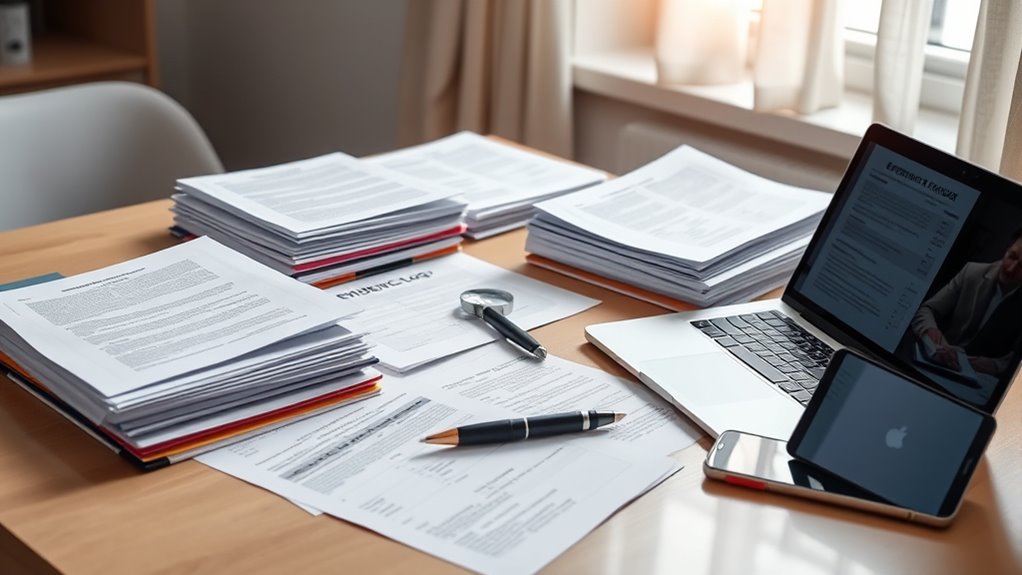To document everything in a high-conflict divorce, start by establishing a consistent recording system using dedicated journals, digital apps, or secure folders. Log dates, times, and detailed descriptions of interactions, incidents, and conversations, including who was involved and the tone of exchanges. Keep copies of emails, texts, and court notices, and back up your files securely. Staying organized and neutral in your records helps protect your interests and offers stronger evidence if disputes arise. Continue to explore how to build a reliable evidence log.
Key Takeaways
- Use dedicated journals or digital tools to log dates, times, and detailed incident descriptions consistently.
- Focus on factual details: what happened, who was involved, where, when, and how, avoiding emotional language.
- Save copies of all communications, including emails, texts, and court notices, with secure backups and timestamps.
- Organize documents into labeled categories such as financials, correspondence, and incidents for quick access.
- Follow up oral conversations with written summaries to confirm accuracy and create a reliable record.

In any project or situation where accountability matters, documenting everything is essential. This principle becomes even more vital when steering through a high-conflict divorce, where every detail can influence the outcome. Effective communication strategies and solid record keeping tips help you stay organized and protect your interests. By maintaining a clear record of interactions, financial transactions, and any relevant events, you create a reliable evidence log that can support your case if disputes arise. This process reduces misunderstandings and guarantees you have factual backup for your claims.
Start by establishing a consistent method for recording information. Use a dedicated journal, digital document, or secure app to log dates, times, and descriptions of conversations or incidents. When documenting communications, include details like what was said, who was present, and the tone of the exchange. If you speak with your ex or their attorney, follow up with an email summarizing the conversation. This creates a written record that can be referenced later, confirming what was discussed and agreed upon. Remember, communication strategies that emphasize written over oral exchanges can prevent misunderstandings and provide clarity in legal proceedings.
Establish a consistent method for recording communications and follow up with written summaries to ensure clarity and accuracy.
Record keeping tips also involve organizing your documentation systematically. Assign folders or labels to different categories such as financial records, correspondence, parenting issues, or incident reports. Keep copies of all relevant documents, including emails, text messages, court notices, and financial statements. When storing digital files, guarantee they’re backed up securely, ideally with timestamps or digital signatures to verify authenticity. Regularly update your record log so it remains current and comprehensive. This habit ensures that if disputes escalate, you’ll have immediate access to the necessary evidence.
Be thorough but concise when documenting. Focus on factual information rather than emotional reactions, which can sometimes weaken your credibility. Stick to the facts—who, what, when, where, and how—and avoid assumptions or opinions. This approach enhances the neutrality of your records and makes them more persuasive in court. Additionally, consider noting any witnesses or corroborating evidence that can support your account of events.
Ultimately, consistent and meticulous documentation forms the backbone of your evidence log. It empowers you to respond confidently to accusations or conflicts and provides a clear narrative of events. When combined with effective communication strategies and diligent record keeping tips, your documentation will serve as a vital tool in managing a high-conflict divorce. It’s about staying organized, truthful, and prepared—so you can steer through the process with confidence and protect your rights every step of the way. Including proper record organization techniques ensures your documentation remains accessible and trustworthy when it matters most.
Frequently Asked Questions
What Types of Evidence Are Most Effective in High-Conflict Divorce Cases?
In high-conflict divorce cases, you find that financial records and communication transcripts are most effective. Financial records clearly show assets, debts, and spending habits, while communication transcripts reveal patterns of behavior or manipulation. By collecting and organizing this evidence, you strengthen your case, making it easier for the court to understand your perspective. Staying meticulous and consistent with these records guarantees you have solid proof when you need it most.
How Should I Organize My Evidence Log for Easy Access?
You should organize your evidence log with a clear labeling system and digital folders for easy access. Create separate folders for different types of evidence, like texts, emails, or photos, and label each file descriptively. Keep a master index that lists all evidence with corresponding folder locations, so you can quickly find what you need. Regularly update your digital folders and labels to stay organized throughout your case.
Can Digital Evidence Be Legally Used in Court?
Imagine you’re in court, and your digital photos of a conflict are vital. Digital evidence can be legally used if it meets criteria for digital admissibility and evidence authentication. You need to guarantee the files are unaltered and properly documented. Courts often look for clear chain of custody and verification. When properly preserved and authenticated, digital evidence holds up, making it a powerful tool in high-conflict divorce cases.
How Often Should I Update My Documentation During the Process?
You should update your documentation regularly to maintain timing consistency and record frequency. Ideally, do it daily or whenever new evidence arises, so nothing gets overlooked. Consistent updates help build a clear, chronological record that can be vital in court. Staying diligent ensures your evidence log stays accurate, complete, and ready when you need it most. Don’t wait—make updating a routine part of your high-conflict divorce process.
What Are Common Mistakes to Avoid When Documenting Evidence?
When documenting evidence, avoid common mistakes like missing opportunities to record details promptly and allowing emotional bias to influence your notes. You might overlook important facts if you wait too long, so update your log regularly. Stay objective, stick to facts, and don’t let feelings color your entries. This helps guarantee your documentation remains credible and useful, preventing missed opportunities that could weaken your case.
Conclusion
Think of your evidence log as a sturdy lighthouse guiding you through stormy waters. Each entry is a beam of light, piercing through confusion and chaos, illuminating the truth. By documenting everything, you build a beacon of clarity and strength that keeps you steady in high-conflict times. Hold onto this light—your careful records—so you can navigate safely, no matter how rough the seas get. Your diligence becomes the steady flame leading you to calmer shores.










